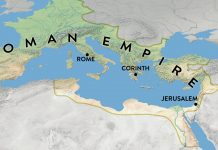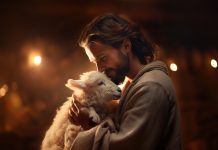The Passion and Resurrection of Jesus Christ—or the Christian Easter—stand out distinctly in the crowded landscape of global religious beliefs and ideas. No other religious tradition contains the concept of a divine person offering Himself as the unique and sufficient mediator through whom God draws near to humanity, and humanity draws near to God.
Among the many facets of Christ’s uniqueness, one particularly remarkable aspect is the prophetic and typological anticipation of His person and mission. While many belief systems are built around the retelling and interpretation of timeless “myths,” Christianity is rooted in events that are entirely traceable in space and time. Where other religions often focus on a hypothetical past beyond human comprehension, the Christian faith is grounded in a life that, long before unfolding in history, was powerfully foretold—both prophetically and typologically.
Prophetic anticipation refers to the detailed predictions made by prophets regarding the life and mission of the Messiah, long before they came to pass in historical reality. Typology, a field within biblical theology, involves the foreshadowing of New Testament realities through people, events, or institutions found in the Old Testament.[1]
A life by the Book
The prophetic anticipation of Jesus Christ stands out for its extraordinary specificity. Figures like Buddha, Confucius, and Muhammad emerged as influential leaders and teachers within their respective cultures and eras, and in some sense, their appearance was expected—but only in a broad, general way. Their arrival aligned with a timeless, universal expectation that humanity might periodically witness the rise of another great religious figure.
In contrast, the significance of Jesus Christ’s role was recognised from the moment of His birth—something that cannot be said of any of the others. No wise men bearing gold, frankincense, and myrrh appeared at Buddha’s birth. No one held the infant Confucius in their arms at eight days old and proclaimed they had seen God’s salvation (Luke 2:30). And Muhammad had no forerunner like John the Baptist, who publicly declared Jesus to be “the Lamb of God who takes away the sin of the world” even before Jesus had spoken a single word in public.
Whereas the stories of Buddha, Confucius, and Muhammad became known as they unfolded, the story of Jesus Christ was written long before it took place. This idea is clearly expressed by the apostle Peter: “He was chosen before the creation of the world, but was revealed in these last times for your sake” (1 Peter 1:20).
The particularity of Christ’s prophetic anticipation is rooted in the divine revelation given long before the Incarnation. This revelation—preserved in the books of the Old Testament—had a precise purpose: to awaken longing for the Messiah, to prepare His way, to announce His coming, and to describe His mission in detail so specific it could not be overlooked. Through the visions granted to prophets and Old Testament writers, God revealed centuries in advance key facts such as the Messiah’s birthplace (Micah 5:2), the time of His birth (Daniel 8 and 9), His virgin birth (Isaiah 7:14), aspects of His ministry, and, most astonishingly, an abundance of precise details concerning His death—including His betrayal, the casting of lots for His garments, the piercing of His hands and feet, the offer of vinegar, and the fact that none of His bones would be broken.[2]
The shadow of the unborn One
Beyond the details foretold through prophecy, the Old Testament contains an entire series of “foreshadows” or “types” of Christ, which serve to deepen the understanding of His person and His work.
Joseph, the son of the patriarch Jacob, was sold into slavery by his brothers, yet he ultimately recognised that everything that had happened to him was part of God’s plan: “You intended to harm me, but God intended it for good to accomplish what is now being done, the saving of many lives” (Genesis 50:20). The meaning that Joseph accepted by faith finds its fulfillment and dramatic expansion in the case of Christ, as seen in the words of the high priest Caiaphas: “You do not realize that it is better for you that one man die for the people than that the whole nation perish” (John 11:50).
The exodus of the Israelites from Egypt serves as a foreshadowing of the deliverance from sin brought by Christ. The Old Testament exodus began with forty years in the wilderness, and similarly, Christ’s work of salvation began with forty days of fasting in the wilderness.
Moses’s successor, Joshua, prefigured Christ both in name—Joshua and Jesus share the same Hebrew root—and in mission. Just as Joshua’s role was to lead the Israelites into Canaan, Christ’s role is to lead His church into the heavenly Canaan, a metaphor for the Kingdom of God.
There are striking parallels between the deeds of the prophet Elisha and the ministry of Christ. Both began their public work at the Jordan River. The connection between their forerunners is also undeniable—Elisha was preceded by the prophet Elijah, while Jesus was heralded by John the Baptist, who was described as a second Elijah. Just as Elisha is credited with performing more miracles than any other Old Testament prophet, Jesus is, without question, the figure associated with the greatest number of miracles in the New Testament.
The three days the prophet Jonah spent in the belly of a sea creature foreshadowed the three days Christ would lie in the tomb (Matthew 12:40). Biblical typology is extensively developed throughout Scripture. As Christian author Catherine Brown Tkacz wrote, Abel, Adam, David, Elijah, Enoch, Isaac, Joshua, Melchizedek, and Moses all foreshadow Jesus and His life in different manners.
The relationship between type and antitype (the fulfillment of the type) can also take on antithetical dimensions. In the Epistle to the Romans (5:14), Adam is referred to as a “pattern” (typos in Greek) of Christ—clearly in an antithetical sense: through Adam, sin and death entered the world, but through the second Adam—Christ—came “one righteous act [which] resulted in justification and life for all people” (Romans 5:18).
A consistent theme across all these typologies—and a defining feature of biblical typology—is that the antitype is always greater than the type it fulfills. If the type was a person or an event, then the antitype—fulfilled in Christ and His work—is absolute.
One of the most profound and symbolically rich typologies in Scripture draws a parallel between the Israelite sanctuary—built after their deliverance from Egyptian slavery—and the person of Jesus Christ. The very purpose of the sanctuary highlights this connection. “Then have them make a sanctuary for me, and I will dwell among them,” said God in Exodus 25:8. These words echo the statement of the Gospel writer John regarding the Incarnation: “The Word became flesh and made his dwelling among us” (John 1:14). Both the sanctuary and Jesus Christ were means by which God took up residence in the midst of His people.
This typology is reinforced in a particularly striking way through language. The sanctuary was referred to as the “tent of meeting.” The phrase “made his dwelling among us,” used by John, translates the Greek word skenóō, which literally means “to pitch a tent.” Through the Incarnation, the divine Son quite literally “pitched His tent” among humanity.
Once inside the Mosaic Sanctuary (or Solomon’s Temple), nearly every element draws a clear and compelling connection to Christ. In the outer courtyard, Christ is symbolised both by the sacrificial lamb and by the priest officiating the sacrifice. In the first chamber of the Sanctuary, known as the Holy Place, He is represented as the Bread of Life and the Light of the world, as signified by the lampstand. His merits are reflected in the fragrant incense rising from the golden altar, symbolising intercession. According to the Epistle to the Hebrews (10:20), the veil that separated the Holy Place from the Most Holy Place was a symbol of Christ’s body.
Within the Most Holy Place stood the Ark of the Covenant, which held the Ten Commandments. Above it hovered the Shekinah—the visible manifestation of God’s presence and glory among His people. Christ is Emmanuel, “God with us” (Matthew 1:23). The ark itself, made of acacia wood and overlaid with pure gold, signified Christ’s dual nature: both human and divine. It contained the Law, about which the psalmist, in an unmistakably prophetic reference to Christ, says that it is “in the inward being” (ESV).
A Greater Sacrifice
Theologian Roy Gane identified five types of sacrifices instituted by God and recorded in Leviticus chapters 1–7: the burnt offering, the grain offering, the peace offering, the sin offering, and the guilt offering. Gane explores why a single type of sacrifice was not sufficient—why God required such variety. His conclusion is that the sacrifice of Christ is so vast and multifaceted that no single ritual could fully represent it. The five offerings are like the facets of a diamond, each contributing to its brilliance.
“The multi-faceted magnificence of Christ’s sacrifice explains why there were different kinds of animal sacrifices at the Israelite sanctuary,” Gane writes. “But no single kind of animal sacrifice could possibly express even the basic aspects of what Christ has done. […] Differences between Israelite sacrifices emphasized various aspects of Christ’s sacrifice.”[3]
Gane notes that the most significant differences between the various offerings lay in how the meat and blood of the sacrificed animal were used—specifically, who received the meat and where the blood was applied.
In the case of the burnt offering, all the meat was consecrated to God and entirely burned on the altar. No one was permitted to eat any part of it. This symbolised the totality of Christ’s sacrifice on our behalf.
The grain offering was unique in that it involved no blood, being made entirely of cereals. It represented the life-giving power of Christ and the benefits it brings.
In a peace offering, the one bringing the sacrifice was allowed to eat a portion of it. This act foreshadowed the blessings received by those who accept the sacrifice of Christ for themselves.
In the case of the sin offering, the blood was applied to the horns of the altar in the courtyard or on the altar of incense, emphasizing the central role of blood as the price of redemption for sinners.
Interestingly, in the guilt offering, the blood was not applied to the horns but to the sides of the altar. In this instance, the blood no longer held the same prominent role—perhaps because this type of offering was always preceded by restitution made to the wronged party, whether God or another person. This detail underscores a critical truth: sin creates a debt that cannot be fully repaid without the sacrifice of Christ, even when the offender does their best to make things right.
As theologian Roy Gane puts it, “It is only when we look at all of the sacrifices that we get a balanced picture of Christ’s sacrifice. The Bible makes it clear that Christ’s sacrifice pays a debt for sins that we have committed and also transforms our lives by His power. Both kinds of benefits are essential for our salvation. To be without one or the other is like losing a wheel on a mountain bike. You don’t go very far on that kind of an unbalanced unicycle”[4].
The typology of the sacrifices instituted by God and recorded by Moses in Leviticus offers a meaningful answer to those who wonder why there were so many types of offerings for a single antitype, so many “foreshadows” for one Person. Even the most eloquent language fails to capture the full depth of His work. The strongest symbols fall short of conveying the irresistible power of His love and the immeasurable greatness of His sacrifice. The richness of meaning in the person and mission of Jesus Christ is so deep and singular that God employed a wide array of symbols, types, and foreshadows to provide a comprehensive glimpse of who He is.
Are the “foreshadows” still needed?
Do the “foreshadows” of the Old Testament still serve a purpose now that we have access to the Light? Is there still value in studying symbols when we already know the reality they pointed to? What use are types when we have the antitype? These are not rhetorical questions. A closer examination of the challenges facing contemporary Christianity reveals that these issues remain highly relevant.
“These things happened to them as examples and were written down as warnings for us, on whom the culmination of the ages has come,” wrote the Apostle Paul (1 Corinthians 10:11). A secularised, post-Christian West shows that believing in Christ two thousand years after His coming can be just as difficult—if not more so—than believing in Him two thousand years before. From this perspective, typological “foreshadows” can serve the spiritual seeker much like archaeological discoveries serve the historian: they confirm the foundations of faith and encourage believers to “hold firmly to our confidence and the hope in which we glory” (Hebrews 3:6).
Foreshadows are a consequence of reality. Their very existence implies the presence of a real object or person that casts them—even when, paradoxically, the foreshadows come before the reality they signify, as in the prophetic foretelling of Jesus. And when those “prophetic foreshadows” possess the diversity and clarity found in Old Testament typology, those captivated by the reality they foreshadow are left with a single, profound challenge: to know Christ. In the words of the Apostle, that means striving “to grasp how wide and long and high and deep is the love of Christ, and to know this love that surpasses knowledge—that you may be filled to the measure of all the fullness of God” (Ephesians 3:18–19).



















